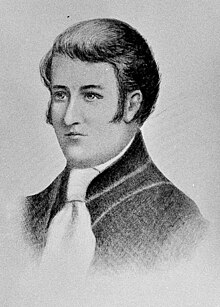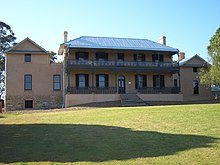Gregory Blaxland
Gregory Blaxland (born June 17, 1778 , Fordwich , Kent in England , † January 1, 1853 , Eastwood in New South Wales ) was an early settler, speculator and pioneer of Australia . He is well known in Australia because he found his way through the Blue Mountains with William Lawson and William Charles Wentworth . What is less well known is that he was one of the signatories of the order to arrest William Bligh during the so-called Rum Rebellion in Australia and that he is known as the founder of cattle breeding and the first successful wine-growing in Australia .
Early life
Blaxland came from a British landowning family and was the fourth son of John Blaxland, a major, and his wife Mary. He went to the King's School in Canterbury . In July 1799 he married Elizabeth Parker, with whom he had five sons and two daughters. He immigrated to Australia on September 1, 1805 with his wife and three children, two servants, a warden, some sheep, seeds, bees, tools, food and clothing. On April 11, 1806 he reached Sydney with his family and his older brother John Blaxland and with 117 convicts on board the ship William Pitt . In Sydney he sold some of the goods he had brought with him for a profit. Blaxland then acquired eight cattle so that he could build up his meat trade and was allocated 16.19 km² of land, the site of his later Brush Farm House on South Creek in Eastwood. The country house is not only the oldest farmhouse in Australia, but also the best preserved and represents the era of construction in the tenure of Governor Lachlan Macquarie . Blaxland was also promised 50 prisoners as farm laborers.
Life
Blaxland was one of the settlers who operated in the British colony and speculated on land exclusively according to their interests. Governor Philip Gidley King warned William Bligh in August 1807 against the ruthless speculation and enforcement of Blaxland's interests. When Bligh took action against the conditions in the British colony of New South Wales, he was arrested and Blaxland was also involved in this measure.
Blaxland needed grasslands for its growing herds of cattle. In 1810 he therefore explored areas around the Nepean River . On May 11, 1813, he started the voyage of discovery from South Creek from the Emu Fields with Lawson and Wentworth to the Blue Mountains (see main article Blaxland Expedition ). They had four servants, five dogs, and four pack horses with them, laden with everything necessary for their exploration. They used different methods than the explorers of the time, because they did not look for the paths through the valleys, but rather they explored the paths from the mountain heights. However, they were already familiar with the unsuccessful paths, and they were familiar with the observations that the botanist George Caley had made over the area from Mount Banks .
They took the route through the mountains over Mount York until they came to a mountain on May 31, 1813, later called Mount Blaxland . From the top of the mountain they saw that there was wide grassland. They had been on the road for 21 days and had covered 93 kilometers to the end of their voyage of discovery. They needed five days for the return journey. Blaxland then received 500 acres (2.02 km²) of land on the Nepean River in the Cooke District of New South Wales at the foot of the Blue Mountains in a charter issued by Governor Lachlan Macquarie.
In 1814, in the midst of the then prevailing economic crisis, Blaxland proposed to Governor Macquarie that a large agricultural company be established. However, the proposed Australian Agricultural Company was not established until later in the 1820s. Macquarie didn't accept Blaxland at the time. He then criticized him heavily, and the governor turned away from him.
Around 1820 Blaxland settled on his first estate in Australia, Brush Farm. From there he undertook various economic activities, such as wine trade, tobacco and grass breeding. Because of his experiments with grass as fodder for cattle, he and his brother John are considered the founders of Australian cattle breeding in arid terrain in Australia and Gregory Blaxland as the first wine grower in Australia to successfully cultivate wine.
Blaxland concerned with land, wine and brandy, and published a book about his journey through the Blue Mountains in 1823. On the occasion of his first wine export to England in 1822 his wines were a medal , the large silver medal by the Royal Society of Arts awarded . He was the first Australian to be honored with a medal for his wines and five years later Blaxland received the gold medal.
His wife died in December 1826. On January 1, 1853, he committed suicide.
Road construction

It is doubted that Blaxland, Wentworth and Lawson were the first to climb the Blue Mountains. John Wilson is said to have succeeded in this towards the end of the 18th century.
However, road construction to western Australia only began after the Blaxland expedition , because up to this point the Blue Mountains looked like an insurmountable bulwark. After the end of this expedition, Macquarie commissioned the explorer George William Evans to make further inquiries beyond Mount Blaxland. Evans left with five men on November 21, 1813 and successfully completed his task seven weeks later, on January 8, 1814. The members of the expedition advanced into the valley of the Lachlan River and were the first Europeans to reach the area of what is now Boorowa and Cowra .
In July 1814, construction of a road through the Blue Mountains began from the Emu Plains. The project was led by William Cox , who was given 30 convicts and eight soldiers as guards for this purpose. When the road was finished after six months, those convicts who had worked hard were released as free citizens. Governor Macquarie traveled this road a year later and founded Bathurst , the first town west of the Great Dividing Range , which includes the Blue Mountains.
The road was later expanded for vehicles and a railway line was built in parallel. In the early days, however, the cattle were driven westwards by a different route.
Honors
Blaxland is not only named after Mount Blaxland in the Blue Mountains, but also the Blaxland River in northern New South Wales , the city of Blaxland and Blaxland County . The Blaxland Riverside Park is located on the Parramatta River in Newington .
To mark the 150th anniversary of the crossing of the Blue Mountains, an Australian postage stamp was issued in 1963 and a silver coin in 1993, depicting the three pioneers Blaxland, Lawson and Wenthworth.
Web links
- Blaxland on adbonline.anu.edu.au
- Information on ebooks.adelae.edu.au
- Blue Mountains Explorer Monuments on hermes.net.au ( Memento from March 26, 2010 in the Internet Archive )
Individual evidence
- ↑ a b c d Historic Buildings - Brush Farm House at ryde.nsw.gov.au ( Memento of February 14, 2011 in the Internet Archive ), accessed on November 26, 2014.
- ↑ Crossing the Blue Mountains George Caley 1804 - doing it the hard way , accessed May 2, 2010.
- ↑ Illustration of the transfer of property to Blaxland by Governor Macquarie on nma.gov.au ( memento of March 17, 2011 in the Internet Archive ), accessed on November 26, 2014.
- ^ Landscape and Archeology Assessment. For the former Brush Farm Estate Eastwood, NSW. Edited by Geoffrey Britton of the City of Ryde: Brush Farm Landscape & Archeology Assessment. Final Report, December 2004 ( Memento of February 21, 2011 in the Internet Archive ) accessed on November 26, 2014.
- ^ Transactions of the Society Instituted at London. Instituted in London for the Encouragements of the Royal Society of Arts (Great Britain) with the Premiums of the Year 1822. Vol. 41-42, Mister Gregory Blaxland on Wine of New South Wales, p. 285. Online on Google Books , accessed 8 May 2010.
- ↑ Information on the official website of the Australian Department of Foreign Affairs and Foreign Trade ( Memento of May 1, 2010 in the Internet Archive ) accessed on November 26, 2014.
- ^ Crossing the Blue Mountains Were Blaxland, Lawson & Wentworth really the first? John Wilson goes bush, 1795 , accessed May 2, 2010.
- ^ Crossing the Blue Mountains. Evans' expedition to Bathurst region, 1814 , accessed May 2, 2010.
- ^ Crossing the Blue Mountains. Cox builds the first road, 1814 , accessed May 2, 2010.
- ↑ 1963 Australian postage stamp depicting Blaxland, Lawson and Wenthworth crossing the Blue Mountains , accessed May 8, 2010.
- ↑ Australian 5 dollar coin from 1993 with Blaxland, Lawson and Wenthworth ( Memento of May 30, 2014 in the Internet Archive ) at: australianstamp.com , accessed on May 18, 2010.
| personal data | |
|---|---|
| SURNAME | Blaxland, Gregory |
| BRIEF DESCRIPTION | Land owner, pioneer of Australia |
| DATE OF BIRTH | June 17, 1778 |
| PLACE OF BIRTH | Fordwich , Kent , England |
| DATE OF DEATH | January 1, 1853 |
| Place of death | Eastwood , New South Wales |


